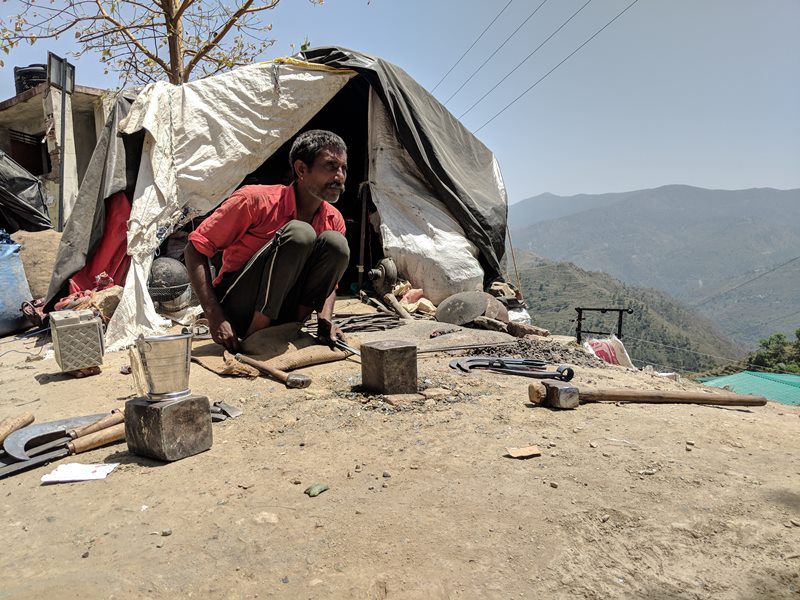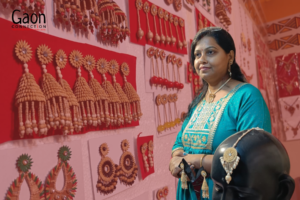Satna, Madhya Pradesh
It appears to be a temporary habitation, but there is colour and a buzz of activity as children run about and play noisily and women go in and out of tents made of colourful tarpaulin. In the background is the non-stop sound of hammer hitting metal, because this is the abode of 25 families of ironsmiths, temporarily set up on the side of the Satna-Panna road.
Of the 100 or so people living there, all of whom belong to the nomadic Lohagadiya tribe that once wrought swords for royalty, there is only 28-year-old Suraj who is able to write his name. No one else can read or write there.
“It is because traditionally we were never sent to school as we constantly moved around,” Sugan Lohgadiya, an ironsmith, told Gaon Connection. “I fear my children will remain unlettered too and I want them to be educated, but my financial situation does not permit me to send them to school,” he said sadly.
Sugan earns a living hand-making iron vessels, farming implements and tools. Lack of money, no land to call their own and a nomadic lifestyle comes in the way of educating their children, he said.
Also Read: COVID-19, lockdown restrictions shatter livelihoods of Rajasthan’s nomadic communities
From royal patronage to penury
The Lohagadiyas, as they are known, claim their origins in Mewar, Rajasthan, but their tribe members are spread out over Madhya Pradesh, Uttar Pradesh and in other states. They are classified as a nomadic or semi nomadic tribe. Their dialects, costumes, traditions and social customs carry strong resemblance to communities in Rajasthan.
This nomadic tribe prides itself in the fact that the birth of a daughter is cause for celebration in their community. And, in weddings, it is the bridegroom who has to bring dowry with him.
“The Lohagadiyas had the patronage of the maharajas of Mewar. They wrought swords and other weapons for the kings. They did this in the reign of Maharana Pratap. When Maharana Pratap died and the royal patronage wore off, they began making farming implements, which they still continue to do,” Chintamani Mishra, a well known literary personality based in Satna, recounted their history. But, the advent of machines and factory-made implements have rendered them almost jobless, he added.
Also Read: Left out in the cold: The Chopan shepherds of Jammu & Kashmir are without identity or many rights
While there are several schemes and welfare programmes for communities such as theirs, little has been done on ground in the 75 years after independence of the country. The Lohagadiyas remain untouched by education. Their traditional occupation has no value in the present world.
“There is a decline in the demand for iron vessels and implements. We do not get as many orders to make them these days,” 55-year-old Binda, who has set up camp with others in her community at Jaitwara in Satna, told Gaon Connection. She had come there along with her two daughters and a son before the second lockdown, she said. “Most of us now buy readymade stuff from the markets and sell them and make a couple of rupees of profit. That is how we are surviving,” she said.
A decade ago, on June 22, 2011, a Nomadic and Semi Nomadic Tribes welfare department was set up in Madhya Pradesh. But a lot more needs to be done to help the Lohagadiyas access various government welfare schemes.
Also Read: Pardhi tribe members still roam the forests of Madhya Pradesh — as nature guides, not hunters
“There are several welfare schemes underway for the Lohagadiya community in the state,” Ramkhelawan Patel, Backward Class and Minority Welfare Minister, Madhya Pradesh, told Gaon Connection. “As far as education goes, their children are given admission in the schools nearest to where they are,” he added. According to him, hostels, ashrams and community centres were also set up to help the Lohagadiyas.
“The earlier generations from this community were completely unlettered, but the present generation is much better off,” said Mishra. But he admitted that they still did not have access to higher education, and that many of them were not even interested in studying. “But the government must take steps to provide training to them to modernise their ancient skills with the help of machines,” the literary personality added.
According to the official website of the Backward Class and Minority Welfare Ministry, Madhya Pradesh, there are 4,535 seats available in the schools, ashrams and the community centres for the children of the Lohagadiya communities in the state.
Also Read: Gadia Lohars in Datia want stability
As per the annual report 2021, published by the Ministry of Social Justice and Empowerment, a grant of Rs 50 crores was made for the welfare of the youth belonging to the nomadic and semi nomadic tribes. Of this, till December 31, 2020, the amount of Rs 13.89 crore had been used up.
Read the story in Hindi.


















